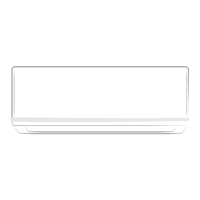Page 22mrcool.com
Outdoor Unit Installation
BEFORE PERFORMING ELECTRICAL
WORK, READ THESE REGULATIONS
1. All wiring must comply with local and
national electrical codes, and must be
installed by a licensed electrician.
2. All electrical connections must be made
according to the Electrical Connection
Diagram located on the panels of the
indoor and outdoor units.
3. If there is a serious safety issue with the
power supply, stop work immediately.
Explain your reasoning to the client, and
refuse to install the unit until the safety
issue is properly resolved.
4. Power voltage should be within 90-100% of
rated voltage. Insufficient power supply
can cause malfunction, electrical shock, or
fire.
5. Circuit, including any switches, should have
a capacity 1.5 times the maximum unit
current (amps).
6. The qualified technician must use an
approved circuit breaker or switch that
disconnects all poles and has has a contact
separation of at least 1/8 in (3 mm).
7. Make sure to properly ground the air
conditioner.
8. Every wire must be firmly connected. Loose
wiring can cause the terminal to overheat,
resulting in malfunction and possible fire.
9. If the unit has an auxiliary electric heater,
it must be installed at least 40 in (1 meter)
away from combustible materials.
DO NOT connect another appliance to the
same circuit.
DO NOT let wires touch or rest against
refrigerant tubing, the compressor, or any
moving parts within the unit.
If you will install the unit on a wall-mounted
bracket, do the following:
TO REDUCE VIBRATION OF WALL-
MOUNTED UNIT
Before installing a wall-mounted unit,
make sure that the wall is made of solid
brick, concrete, or of similarly strong
material. The wall must be able to support
at least FOUR times the weight of the unit.
1. Mark the position of bracket holes based on
dimensions in the Unit Mounting Dimensions chart.
2. Pre-drill the holes for the expansion bolts.
3. Clean dust and debris away from holes.
4. Place a washer and nut on the end of each
expansion bolt.
5. Thread expansion bolts through holes in mounting
brackets, put mounting brackets in position, and
hammer expansion bolts into the wall.
6. Ensure that the mounting brackets are level.
7. Carefully lift the unit and place its mounting feet on
the brackets.
8. Using a wrench, bolt the unit firmly to the brackets.
If allowed, you can install the wall-mounted unit with
rubber gaskets to reduce vibration and noise.
Step 4: Connect signal and power cables
The outside unit’s terminal block is protected by an
electrical wiring cover on the side of the unit. A
comprehensive wiring diagram is printed on the inside
of the wiring cover.

